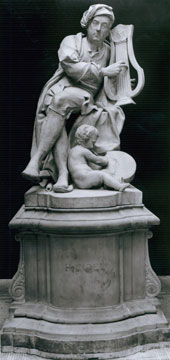 At the heart of Vauxhall Gardens, the favorite pleasure ground of eighteenth-century Londoners, stood a magnificent statue of the era’s most eminent composer, George Frideric Handel (1685–1759) by Louis-François Roubiliac. Born in Germany, Handel lived in London for most of his adult life and composed many of his most famous works there including Messiah and theMusic for the Royal Fireworks, which a huge crowd gathered to hear at Vauxhall in 1749.
At the heart of Vauxhall Gardens, the favorite pleasure ground of eighteenth-century Londoners, stood a magnificent statue of the era’s most eminent composer, George Frideric Handel (1685–1759) by Louis-François Roubiliac. Born in Germany, Handel lived in London for most of his adult life and composed many of his most famous works there including Messiah and theMusic for the Royal Fireworks, which a huge crowd gathered to hear at Vauxhall in 1749.
A popular resort since the 1660s, Vauxhall Gardens re-opened after extensive renovations in 1732 under the proprietorship of Jonathan Tyers. On a summer’s evening one could stroll in the newly refined setting while listening to music; in the bandstand, known as the Orchestra, professional musicians performed a varied repertoire of vocal and instrumental music. Major composers such as Thomas Arne wrote large numbers of songs to be performed at Vauxhall by celebrated vocalists.
Vauxhall was also one of London’s first spaces for the public exhibition of contemporary painting. Among Tyers’ improvements to the Gardens was the construction of supperboxes where visitors to the gardens could dine. These were adorned with decorative paintings, mostly by Francis Hayman, depicting games and rustic pastimes.
The marriage of art and music at Vauxhall was most apparent, however, in Roubiliac’s statue of Handel itself, erected in 1738. The composer is posed informally, holding the lyre of Apollo or Orpheus and leaning on a stack of his own musical scores. Among them is Alexander’s Feast, an oratorio celebrating the power of music to sway the emotions. A contemporary found it fitting that Handel’s statue should preside “where his Harmony has so often charm’d even the greatest Crouds into the profoundest Calm and most Decent Behavior.”
 Louis-François Roubiliac (1695–1762)
Louis-François Roubiliac (1695–1762)
George Frideric Handel, ca. 1738
© v&a Images / Victoria and Albert Museum
www.vam.ac.uk
